To brew a mead, one must be patient. One must be willing to brew a beverage that can take years to develop and mature. Yes, I said years. Patience has its place in life. Instant gratification also has its place, and that is what homebrewing cider and beer is for. I had been wanting to make a mead for a very long time, so I figured if I could be patient to begin making it for that long, I could be patient enough to brew it. My friend John, who I have been brewing beer with, is also an experienced mead maker, so we decided to have a mead day.
Logan, after watching her papa brew, decided she wanted to make her own mead and was willing to patiently wait years for it to be ready. The recipe decided upon was a spiced chai mead, made with her favorite Celestial Seasonings decaf chai.
Logan’s Honeybee Chai Mead
(5 gallons)
13 Lbs wildflower honey
4.5 gallons water
40 chai tea bags
1 Tbsp yeast nutrient
WYeast Dry Mead Yeast #4632
Make yeast into a starter the day before. Boil 1 gallon water, and steep tea bags for 10 minutes. Boil honey in 3.5 gallons water, then combine. Counter flow chill in a wort chiller. Pour into a sterilized 5 gallon carboy. Add yeast nutrient and pitch yeast. Swirl carboy and top with an air lock. Continue to swirl daily. When specific gravity reading is down by 1/3, add 1 tsp of yeast nutrient. When specific gravity readings are stable, rack into a secondary fermenter.
John is big on controlling the yeast culture used for fermentation, so he boiled the mixtures to kill off wild yeasts before adding our chosen yeasts. We decided to do this on his big gas burner outside, and somehow the aroma of hot honey attracted the swarm of honeybees from across the road living in an old hollow tree.
At first just a few were buzzing around, but pretty soon the whole swarm came and we couldn’t be out on the back porch anymore. They cleaned up and ate all of the bits of honey left clinging to the spoon and chai tea bags. They especially loved the bowl of skimmed foam from the pot.
John used to have bees around, so he knew how to properly suit up to go out and take care of the mead. He used a mesh winemaking bag as a bee mask. The bees made the day very exciting, and really seemed very apropos as we were making mead after all.
I decided to make a mint mead based on a delicious mint wine tasting experience I had on a visit to my friend and favorite vintner, David Hamilton a couple years back. He travels around and wildcrafts fruit for his winery (that’s David Hamilton Winery if you’re interested in checking it out) and he had made a mint wine from wild peppermint growing by a creek up in the mountains. It was a hot august day, and that wine was one of the most refreshing things I had ever tasted. My friend, John, also pulled out a vintage mint mead the other day that was quite tasty, so I decided to try both a wine and a mead to compare.
Lara’s Homestead Peppermint Mead
(3 gallons)
8 Lbs honey
11 oz fresh peppermint
2 2/3 gallons water
1 tsp yeast nutrient
WYeast Dry Mead Yeast #4632
Make yeast into a starter the day before. Chop and mash mint with a potato masher. Boil one gallon of water and steep mint for 15 minutes. Mix 1 2/3 gallon water and honey, heating to 165 F. Counter flow chill with wort chiller. Pour into a sterilized primary fermenter (5 gal carboy in this case) and stuff mint into the carboy. Add nutrient and pitch yeast. Swirl around and top with an air lock. Continue to swirl daily. When the specific gravity reading is down by 1/3, add 1 tsp yeast nutrient. When specific gravity readings are stable, rack into a secondary fermenter. Bottle bewteen 6 months and a year when specific gravity readings are stable for a month.
I cannot even recount how pungently wonderful the minty smell was in the house while brewing up the mint infusion for my mead and wine.
Lara’s Homestead Peppermint Wine
(5 gal)
18 oz fresh peppermint
10.5 oz organic cane sugar
4.5 gallons water
1 tsp citric acid
1 tsp yeast nutrient
2 pkgs. Bordeaux WYeast #4267
Make a yeast starter the day before. Chop up and mash mint a little with a potato masher. Boil one gallon of water and let the mint steep for 15 minutes. Dissolve sugar in 3.5 gallons of water and heat to 165 F. Counter flow chill with wort chiller. Pour into a sterilized primary fermentation bucket and pitch yeast. Stir with a sterilized spoon, and top with an air lock. When the specific gravity reading is down by 1/3, add 1 tsp yeast nutrient. When specific gravity readings are stable, rack into a secondary fermenter.
Blackberry Meat Mead
(No actual meat was harmed in the making of this mead. No raccoons either.)
(4 gallons)
11.5 Lbs honey
3.5 gallons water
3 Lbs, 9 oz blackerries
4 Lbs blackberries
1 tsp citric acid
1 tsp yeast nutrient
WYeast Dry Mead Yeast #4632
Make yeast starter the day before. Heat 3 lbs blackberries with 2 qts water at 165 F. Dissolve 3 gallons of water with honey at 165 F. Combine, then counter flow chill with wort chiller. Pour into a sterilized 5 gallon carboy. Add nutrient and pitch yeast. Swirl carboy and top with an air lock. Continue to swirl daily. When the specific gravity reading is down by 1/3, add 1 tsp yeast nutrient. When specific gravity readings are stable, rack into a secondary fermenter.
John’s Extra Fancy Blueberry Mead
(4 gallons)
11. 5 lbs honey
3.5 gal water
5.5 lbs blueberries
4.5 lbs blueberries
1 tsp citric acid
1 tsp yeast nutrient
WYeast Dry Mead Yeast #4632
Mix up yeast starter the day before. Macerate 5.5 lbs blueberries with 2 qts water at 165 F. Filter out skins. Dissolve honey in 3 gallons of water at 165 F. Combine, then counter flow chill in wort chiller. Pour into a sterilized 5 gallon carboy, add yeast nutrient, and pitch yeast. Swirl carboy and top with air lock. Continue to swirl daily. When the specific gravity reading is down by 1/3, add 1 tsp yeast nutrient. When specific gravity readings are stable, rack into a secondary fermenter.
After about a year, when the mead goes clear and the specific gravity readings have stabilized for a month, it’s bottling time. And then more waiting. John recommends trying a bottle every year. If it tastes good, it’s ready to drink. If it tastes nasty, wait another year. Very simple, but much patience is required.
And after many years of waiting, the people drank their mead, and it was good.
Cheers.
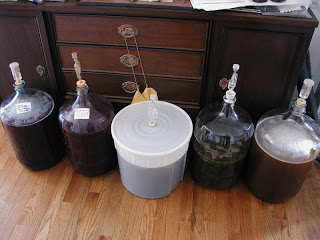
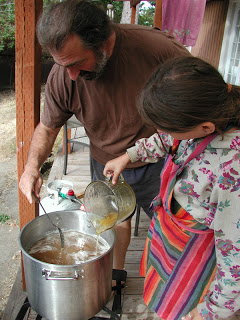

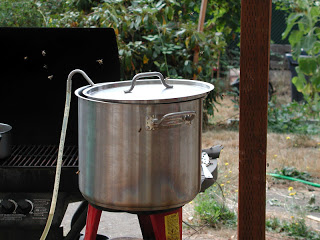
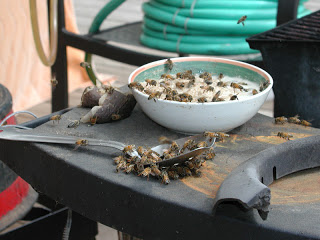
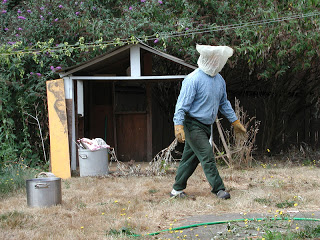
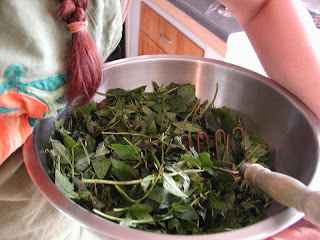
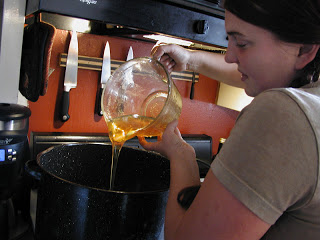
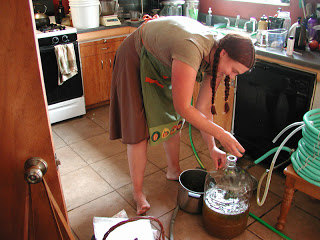
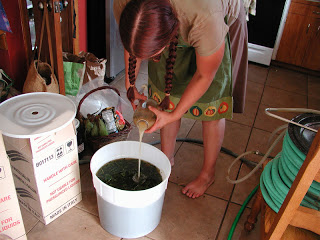
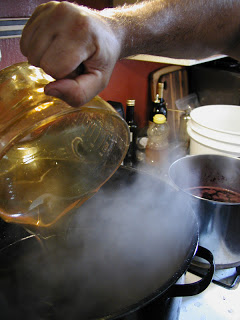
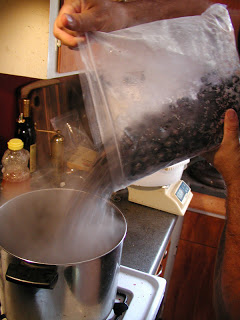
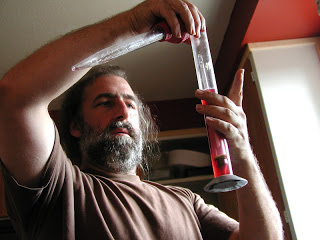
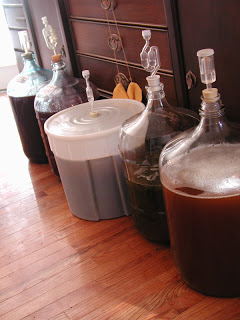
Leave a Reply